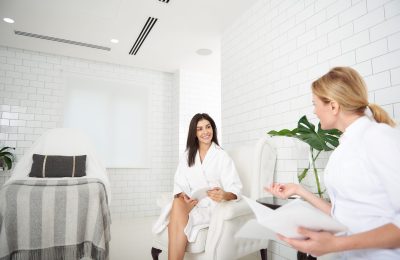In the spa industry, hiring the right employee always benefits owners By Brooke SmithFor employers, hiring a qualified employee can…
Finding Financing – Part 2
Expenses Galore
As a hopeful spa owner, you need to know all of the potential costs associated with running the business. To break it down, what will your initial investment be?
When starting from scratch… you’ll need to buy land, pay for contractors, workers, permits and materials to construct your building. Engineers will need to be contracted in order to verify proper construction of the foundation and building. Electricians, plumbers and painters generally charge more per hour than general labourers, but are necessary to ensure quality work.
When using an existing building… … will you rent from the current owner or buy the building/ facility flat out? Regardless, you will likely renovate to suit your needs. Like starting from scratch, this requires contractors and skilled workers, as well as permits. Sometimes buildings can be sold as-is, with old furniture or other objects still inside. If you get a good deal on a building because of this, don’t forget to factor in removal costs. Dumpsters and hauling aren’t cheap. Does anything need to be replaced? Toilets, windows, doorknobs, light fixtures, sinks, floors, etc. Is everything up to code?
When tackling standard spa and business expenses… … products are going to be expensive and tricky. You want enough product to handle the client load, but not so much that you’re tying up excessive amounts of money that could be put to use elsewhere. Display cases for products are also important, and can run from $100 to well over $1,000. What will it cost to pay employee salaries? Not just stylists, estheticians or massage therapists, but accountants, Web designers and receptionists. There are obvious purchases such chairs, tables and mirrors, but don’t forget the mechanical organs of the business – a cash register, computer, telephones, security system, audio system, televisions. Then there are the everyday bills such as utilities. “Don’t overestimate what you’ll be bringing in. If anything, make sure you underestimate so that you don’t find yourself in trouble,” says Karen Legendre, Manager/Owner/Founder of Spa Cantik in Regina, Saskatchewan. “If I had to do it again, I would try to get more funding. The realistic numbers were more than we thought they’d be. Some of the building expenses were more than I’d anticipated. Running and maintaining the business daily too: I thought we would be busier right from the beginning and it’s really easy to start running a bit behind.”
Legendre’s advice: plan for business to start slow, even if you believe otherwise, and allot for that in the financial plan. Don’t assume the spa will generate enough money to even pay for electricity, snow removal, Internet connection or phone lines. In order to drum up more clients, Legendre undertook a large advertising campaign, which reached further into the pockets of her young business.
“You will want to do extra advertising in the first six months in order to get your name out there, and I didn’t really plan for the amount we’d spend on that,” she says.
Getting It Right
To get the amount of funding you set out to acquire right, an entrepreneur should prepare a set of three projected financial statements: an income statement, a cash flow statement and a balance sheet.
The income statement estimates your total expected revenue and expenses for the first year of operation, while the cash flow statement attempts to project the flow of cash in and out of the business over a given period of time in order to help plan for and avoid cash shortages. The balance sheet gives a summary of what your business will own and weighs it against what it will owe to others in order to determine the net worth of the spa. These documents give lenders a clear idea of the viability of the spa as a profitable business in addition to identifying exactly what is needed to get the business moving.
Knowing the amount of funding needed, an entrepreneur can look at the money already available through personal savings or equity (it is advised by the Canada/Manitoba Business Service Centre that entrepreneurs risk a reasonable amount of money in their own business to improve lender confidence) that he or she might have and identify exactly how much total financial assistance is needed. An average spa leasing or renting a space will require between $120,000 and $150,000 to get started. Starting from scratch, that number can easily triple.
There Are Options, But Nothing Is Guaranteed
Most people don’t have easy access to the kind of money required to open a business such as a spa. Fortunately for entrepreneurs and business-ownership-hopefuls, there is money out there to be had, and it can come in the form of a loan, an investment or a grant.
Loans… …are expected to be paid back to the lender, often with interest. Financial institutions like banks or credit unions are the most common purveyors of interest-driven funding, though the government does participate in this kind of financing. Although she has full ownership of the spa and facility housing it, Joanne MacLeod, owner and operator of the Healing Touch Health Spa in New Glasgow, N.S. maintains a business line of credit, a standard source of bank-provided funding. Loans can also come from family members. “Love money,” as it is called, can put strain on personal relationships, so be sure to set ground rules even if it seems too formal at first.
Investments… …can come from a variety of sources, but can mostly be boiled down to angel investors and venture capitalists, according to the Business Development Bank of Canada. Angel investors are essentially the little brothers to venture capitalists, investing a maximum of $2 million to the venture capitalist’s minimum of around $3 million. The National Angel Capital Organization (www. angelinvestor.ca) is a good place to look for potential angels, while Canada’s Venture Capital and Private Equity Association (www.cvca.ca) provides access to venture capitalists.
Grants… … generally come from the government or non-profit organizations and are meant to help strengthen the domestic economy or develop the business presence of a certain group. These usually involve an application process that relates to very specific criteria. Industry Canada’s Small Business Internship Program, for example, provides small and medium-sized businesses financial support to hire a post secondary student intern to assist them in their adoption of information and communications technologies to increase their productivity. Something that entrepreneurs must come to terms with when seeking funding is that even though there are many sources of capital, getting your share is far from easy.
“I had a business partner who had a very good salary and had some money put away, so we bought the location for the spa together,” says MacLeod. “But after that I couldn’t get any more money. I applied for grants and went to a lender, but they said I had negative equity.” MacLeod had never owned a home, and although she already had a strong customer base from previous employment as a massage therapist, she couldn’t convince lenders that her business was a viable one. In a nutshell, no equity means no leverage, and no leverage means that the business is at a disadvantage when seeking loans, investments or grants.
Legendre faced a number of disappointments as well when she set out to get her share of the government’s small business grant funding.
“I didn’t find any government programs that I would qualify for; it was all very specific stuff,” she says. “After that, I went to [Women Entrepreneurs of Saskatchewan, Inc.]. I knew they were there in the city and always wanting to help women get started in business.”
For Legendre, like any other entrepreneur, it was all about finding the right source of funding.
The Face-To-Face
Eventually you will meet with bankers or investors, and to give yourself the best possible odds of success you need to be well prepared. They will likely ask direct questions such as how you intend to use the money you’re asking for, and how you plan to pay it back.
Confidence and knowledge of your business is key. Lenders want to know that you are convinced of the viability of the business based on experience and research, not just pure ambition. In line with this, be well informed about your business and the industry it’s part of.
Be prepared for rejection. Not many entrepreneurs get exactly what they want on their first stop. Meeting more potential lenders will increase your knowledge of the business and will build confidence and comfort in the presence of lenders
Talk the Talk
To walk the walk, you have to talk the talk. Here are some common financial terms you should know:
- Working capital – money used for the day-to-day operations of the spa.
- Capital assets – funds involved in the purchase of equipment.
- Long-term debt and short-term debt – refers to loans that will exceed one year or will not, respectively.
- Equity – personal money used to gain leverage when approaching additional lenders.
- Leverage – a measure of the spa’s ability to borrow money.
- Net income – the difference between revenues and expenses.
- Breakeven point – the point at which revenues equal expenses.
The Government Options
There are hundreds of sources for funding startups in Canada, and for many entrepreneurs it can be difficult to know where to start. Below you can find the tip of the iceberg. This list is just a small snapshot of government funding available in Canada, it is meant to act as a launching point from which entrepreneurs can explore the corridors of the funding maze.
• The Canada Small Business Financing Program (CSBFP) is a fund for establishing, expanding, modernizing and improving small businesses in Canada. According to Erin Baldwin at TD Canada Trust, it can provide a maximum of $500,000 for any one business, of which no more than $350,000 can be used for purchasing leasehold improvements or improving leased property and purchasing or improving new or used equipment. “We’d encourage people to speak with a TD Small Business Advisor to learn more about the eligibility of the CSBFP, which is a great program for new businesses,” says Baldwin.
• Business Development Bank of Canada (BDC) is a venture capital firm that offers long-term financing and consulting to small and medium enterprises. • Aboriginal Business Canada provides non-repayable contributions of up to $99,999 per project, for eligible individual entrepreneurs.
• The Ontario Community Futures Development Corporations provides repayable financing of up to $150,000 on commercial terms through loans, loan guarantees or equity investments to help finance new or existing small businesses that help maintain or create jobs in rural and northern communities.
• The Canadian Youth Business Foundation (CYBF) Loan Program provides loans of up to $15,000 to young entrepreneurs between 18 and 34 to help cover start-up costs.
• The Self Employment Assistance program provides financial support to unemployed people eligible for unemployment assistance to get their businesses up and running. Additionally, entrepreneurs should explore funding options with more than one bank, and should seek out targeted non-profit organizations such as Women Entrepreneurs of Saskatchewan Inc. or non-bank lenders such as Nova Scotia Business Inc.
- Opening A Spa: Parts 1 – 8Part 1: The BusinessPart 2: Finding FinancingPart 3: Location, LocationPart 4: Moving InPart 5: HiringPart 6: ProtocolsPart 7: Marketing Your SpaPart 8: Head of the Class




